.
28.02.2016


China's Tiangong-2 space lab to launch in September, dock with Shenzhou-11 in October







BEIJING, The rockets expected to carry China's second orbiting space lab Tiangong-2 and the Shenzhou-11 manned spacecraft into space have been delivered to Jiuquan Satellite Launch Center in northwest China.
A statement issued by the Manned Space Engineering Office on Saturday said that the center is where the assembly and tests of the rockets, which belong to the Long March-2F rocket series, will be carried out.
The rockets were sent from Beijing Wednesday by rail.
Compared with their predecessors, the two rockets feature technical improvements to improve their safety and reliability, according to China Academy of Launch Vehicle Technology.
Tiangong-2 is scheduled to launch in mid-September, and Shenzhou-11, which will carry two astronauts to dock with Tiangong-2, will be sent into space in mid-October.
Quelle: Xinhua
-
Tiangong-2 and Shenzhou-11: Rockets head to launch site for space station test missions
Two Long March 2F rockets that will launch China’s first human spaceflight missions since 2013 are being transported to the Jiuquan Satellite Launch Centre ahead of launch next month.
This is the first time that two Chang Zheng 2F rockets are being transferred by rail to the launch centre at the same time, due to the tight schedule of the missions.
Tiangong-2, the country’s second space lab will launch in mid-September and will be visited soon after by a crewed Shenzhou spacecraft carrying two astronauts.

Above: A Long March 2F rocket segment being loaded on a train bound for the Jiuquan launch site (CCTV/framegrab).
The two rockets are not identical, with the launch vehicle for Tiangong-2 featuring a wider payload fairing at the top to facilitate the space lab.
The Long March 2F for the Shenzhou mission features a tell-tale emergency escape system atop the rocket to separate the spacecraft from the rocket in the event of launch failure.
"We have to start the preparations of the second launch mission four days before the implementation of the first launch. During preparation of the rocket for launching Tiangong-2, we will not have enough personnel and vigour to prepare the other rocket, thus we adopt this measure so that it will take a shorter time to get ready for both launch missions," said Zhang Zhi, the chief designer of the CZ-2F rockets.
China has launched ten Long March 2F rockets, suffering no failures. The first was the Shenzhou-1 mission in 1999, while Shenzhou-5 in October 2003 made Yang Liwei China’s first astronaut in space.
Tiangong-2 arrived at Jiuquan on July 9 and is undergoing testing ahead of launch.
Preparation for space station
The Tiangong-2 and Shenzhou-11 spacecraft will rendezvous and dock in orbit 393 kilometres above the Earth, the same altitude planned for China’s future modular space station, which is expected to be completed around 2020.
The aim is to verify docking and rendezvous technologies for the space station. The orbit will be higher than that of Tiangong-1, the country’s first space lab launched in 2011 which is now in an apparently slowly decaying orbit that could see it return to Earth around late 2017.
The Tiangong-2 space lab will also be used to test life support systems, with the two visiting astronauts set to stay aboard Tiangong-2 for 30 days, and more than doubling the national record for time spent by astronauts in space.
-

Above: Shenzhou-11 spacecraft undergoing tests in February 2016 (CCTV/framegrab).
Next year, Tiangong-2 will also be used to test on-orbit propellant resupply, which is a key technology for the stable operation of a space station.
China’s first cargo resupply vessel, Tianzhou-1, is expected to launch on a new Long March 7 rocket from Wenchang in the first half of 2017.
"We must collect gas from the fuel tank of the Tiangong-2 into a cylinder, so that a pressure difference will be formed to ensure that the propellant will be supplied from the cargo ship to the space lab," Zhu Zongpeng, chief designer of Toangong-2, told CCTV.
Space science laboratory
Tiangong-2 is apparently the modified back-up to the Tiangong-1 spacelab, with a similar mass of 8.5 tonnes, but various upgrades will make the astronauts’ stay more comfortable.
But Tiangong-2, which is currently under pre-launch testing at Jiuquan, will also carry 51 payloads and 14 experiments on board, according to the Chinese Academy of Sciences.
Research will be in the areas on space biology, fluid physics in microgravity, fundamental physics, Earth science, astronomy and the space environment.
These include a space-Earth quantum key distribution (QKD) and laser communications experiment, an atomic clock using laser-cooled rubidium atoms, the Sino-Swiss POLAR gamma ray burst detector and a microwave altimeter for tracking ocean dynamics.
Zhu also stated that, along with the Shenzhou-11 and Tianzhou-1 missions, a third task for Tiangong-2 involves running experiments for China's future space station, including technical experiments and relevant experiments related to repair work.
The Tianzhou-1 cargo vessel will also carry experiments, including a cell bioreactor, a two-phase fluid instrument and an accelerometer for flight demonstration.
If all goes well for Tiangong-2, Shenzhou-11 and Tianzhou-1, and the launch of the new heavy-lift Long March 5 rocket required to loft the space station modules goes smoothly later this year, the core module of the space station will be expected to launch around 2018.
Featuring one core and two experiment modules, the Chinese Space Station complex will also include a Hubble-class optical telescope that can dock with the station, and will be open to international crews, experiments and even modules being received.
Quelle: gbtimes
-
Update: 9.09.2016
-
Tiangong2 and its carrier rocket, Long March 2F, transferred to launch pad at Jiuquan, NW China’s Gansu Province





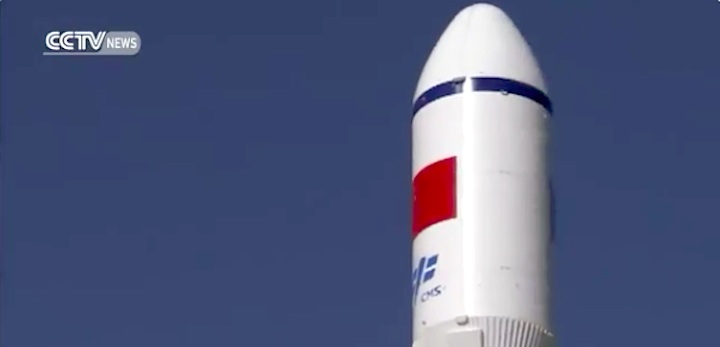




-
What are the missions of Tiangong-2?

Tiangong-2 will verify key technologies for China’s future space station. We now take a look at some of the main objectives and missions that Tiangong-2 is set to accomplish.
Unlike the Tiangong-1, China’s first prototype space lab, the Tiangong-2 is designed to have astronauts stay in space for a longer time. The Shenzhou 11 spacecraft, to carry two astronauts, will blast off later to dock with the Tiangong-2. These two astronauts are expected to live in the space lab for up to 30 days.
The second mission of the Tiangong-2 is to dock with a cargo ship next year, resupplying the space lab. The "Tiangong-1" was designed for a two-year service in orbit, while the "Tiangong-2" is expected to operate much longer, when with new propellant and other resources.
Last but not least, a record number of 14 experiments will be carried out in the Tiangong-2. These experiments will cover cutting edge technologies like space materials science and space life science. And, two of the experiments will be operated by astronauts aboard the space lab.
All in all, the Tiangong-2 is another pioneer of China’s future permanent manned space station, which is schedule to enter into service in 2022.
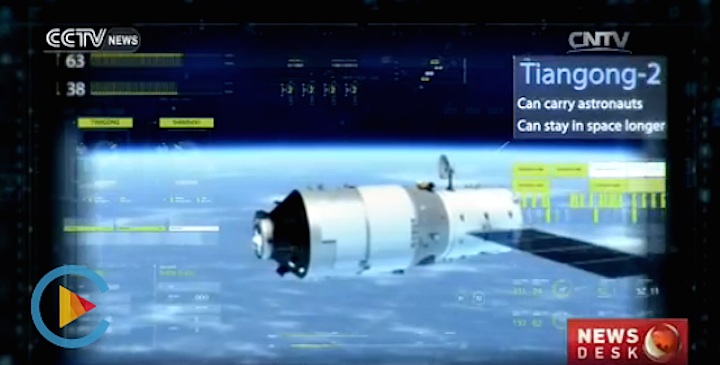


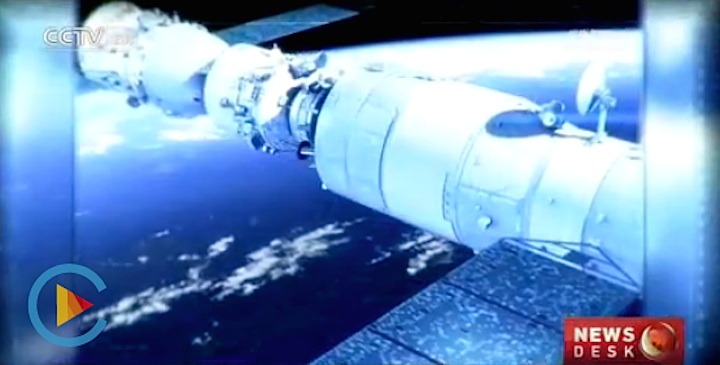
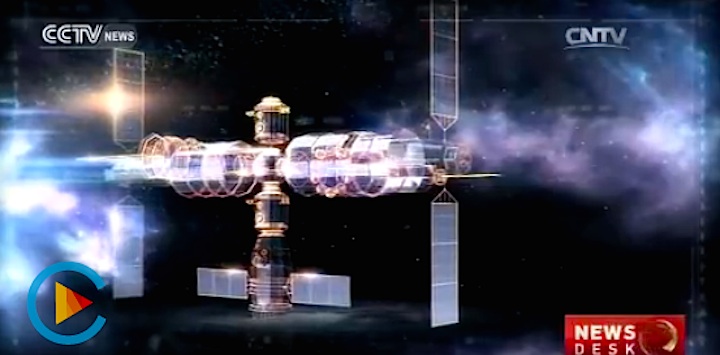


Quelle: CCTV
-
Update: 10.09.2016
.
China's second space lab Tiangong-2 to be launchedChina's second space lab Tiangong-2 is scheduled to be put into space between September 15 and 20, according to the office of China's manned space program.
The space lab was transferred with its carrier rocket to the launch pad at Jiuquan Satellite Launch Center in northwest China on Friday, said a statement from the office.
It took 90 minutes to complete the transfer from the assembling center to the launch pad.
"The completion of the transfer signals that the space lab Tiangong-2 mission has entered its launching stage," it said.
Technicians completed testing on the assembling of the lab and the rocket after they had been separately delivered to the launch center in July.
In the next few days, the launch center will continue testing rocket and inject propellent before the launch.
Tiangong-2, which can enable two astronauts to live in space for 30 days, is capable of receiving manned and cargo spaceships and will be used for testing systems and processes for mid-term space stays and refueling.
It will also be involved in experiments on aerospace medicine, space sciences, on-orbit maintenance and space station technologies.
China's first space lab Tiangong-1, which was launched in September 2011, ended its data service earlier this year. It had docked with Shenzhou-8, Shenzhou-9 and Shenzhou-10 spacecraft and undertaken a series of experiments.
Quelle: Xinhua
-
Update: 12.09.2016
.
Vigil for Tiangong 2
 illustration only |
September 15 marks the opening of the launch window for China's Tiangong 2 space laboratory. It will also probably be the actual launch date. The launch window extends to September 20, but China has no good reason to delay the launch of Tiangong any later than necessary. There seem to be no technical reasons that would prevent it from launching at the first chance.
We have been given sparse information in the lead-up to the launch, but what little we know sounds very positive. We can also infer that other unreported events are going well, judging by China's previous experience with this type of mission.
Tiangong 2 will undergo a checkout phase after launch, as its systems are put through its paces. Checking the environmental controls will be especially important. The internal cabin atmosphere will need to be tested and filtered for any small floating particles.
A long checklist of tasks will need to be ticked off before Tiangong is judged fit for a crew. But this will not stop preparations for the next launch from continuing.
China hopes to launch two astronauts to Tiangong 2 aboard the Shenzhou 11 spacecraft soon after Tiangong 2 reaches orbit. The launch can be delayed or scrubbed if Tiangong is not healthy, but that seems unlikely.
So, we must wait a little longer for Tiangong 2, but probably not too long. Even a last-minute problem on launch day will probably only postpone the launch by around 48 hours, or less. China will almost certainly fly Tiangong 2 during the launch window.
Official Chinese media coverage has been less than satisfying for space buffs so far, but that's typical. Hopefully the pace will quicken just before Tiangong 2 launches. This will be a critical test for how Chinese space media policies are developing. To a large degree, they are influenced by changes to general media policies for China, but the space program has its own unique sensitivities. Recent times have seen a tightening in policies for both.
We seem to have been denied the usual media appetizers of snippets on experiment plans or technical upgrades. That's disappointing, but we could learn more later. China made brief references to small technical improvements to the launch vehicle, but this is not surprising. China is always steadily tweaking its rockets with incremental engineering changes. The recent loss of a Long March 4C rocket could also temper media coverage.
The vigil for Tiangong 2 continues as we await the countdown.
Quelle: SD
-
Update: 15.09.2016
.
Tiangong-2 to launch on Thursday, China announces
Tiangong-2 is a prototype spacelab that will test life support, repair systems and refuelling technology for the future 60-tonne Chinese Space Station, the core module of which is due to launch in 2018.
The launch will be broadcast live by Chinese state media, with the launch scheduled for 22:04 Beijing time (10:04 EDT) in the Gobi Desert in Northwest China.

Above: Tiangong-2 in June 2016 (CCTV/Framegrab).
Wu Ping, deputy director of the China Manned Space Engineering Office, said the Long March 2F carrier rocket, which will lift Tiangong-2, is currently being filled with propellant.
The spacelab will receive the visit of the Shenzhou-11 crewed spacecraft to accomplish the country's first medium-term stayof astronauts in orbit.
Mission preview: China to launch Tiangong-2 in step towards space station
The press conference included questions from journalists, focusing on the mission highlights, science objectives, international cooperation, progress since the first spacelab missions involving Tiangong-1, and the benefits of space activities for the public.
Asked about what China has done to minimise the risks, Ms Wu spoke of the great difficulties of accessing space, making reference to recent unspecified space launch failures, one of which China suffered earlier this month.
She added that the Long March 2F launch vehicle, a variant of which will be lofting Tiangong-2, was of very high quality, having suffered no failures, and that great attention had been paid to quality of components, systems and rehearsals.

Above: Tiangong-2 atop its carrier rocket heading from testing building (background) to the launch tower at Jiuquan.
The final question was on the situation of China's first spacelab, Tiangong-1, which it was announced in March had ended its data transmission, sparking speculation of a dangerous, uncontrolled return to Earth.
Wu Ping stated that Tiangong-1 was currently orbiting at an altitude of 370 km and declining by 110 metres per day. Based on this, authorities expect the spacelab to reenter in the latter half of 2017.

Above: China's previous crewed mission, Shenzhou-10, docking with Tiangong-1 in 2013.
Ms Wu did not state a specific plan for de-orbiting, suggesting that the reentry will be uncontrolled. She added that the chances of the debris causing damage are considered to be very low.
Step towards a space station
Tiangong-2 will be lifted into an orbit 393 kilometres above the Earth, where it will be joined by the crewed Shenzhou-11 spacecraft in October.
The 8.6 tonne Tiangong-2, which translates to “Heavenly Palace 2”, will host two astronauts for 30 days and will also carry a range of scientific payloads, including POLAR, a collaboration between Swiss, Polish and Chinese institutions to study gamma ray bursts.
Piggybacking on the Tiangong-2 launch will be Banxing-2, a technology development satellite made by the Shanghai Academy of Spaceflight Technology (SAST).
Armed with 25 megapixel optical cameras, the small satellite will orbit close to and snap Tiangong-2 and the visiting crewed Shenzhou-11 spacecraft.
If all goes smoothly, Tiangong-2 will be visited by China’s first refuelling and cargo vessel, Tianzhou-1 in the first half of next year, launched on a Long March 7 rocket from the new Wenchang spaceport.
The Shenzhou-11 and Tiangong-2 missions together will bring China one step closer to the ultimate goal of its three-step human spaceflight programme, a large, permanently inhabited space station, says Joan Johnson-Freese, an expert on the Chinese space programme and a professor at the US Naval War College, expressing her personal views.
"If all continues to go well for China with the upcoming Shenzhou and Chang'e lunar robotic missions then it may not be long before China announces an official lunar human spaceflight program; something long anticipated," Johnson-Freese states.
Quelle: gbtimes
---
Erfolgreicher Start von China´s Raumlabor Tiangong-2 / Update






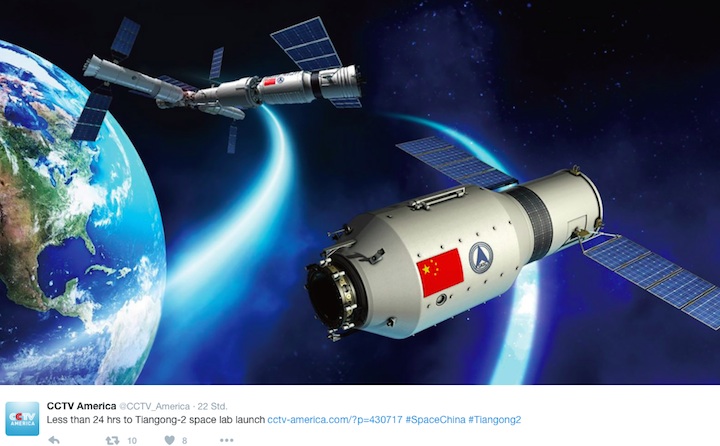
Quelle: CCTV
-
Update: 16.09.2016
.
Tiangong-2 takes China one step closer to space station
China's Tiangong-2 space lab blasted off on Thursday, marking another milestone in its increasingly ambitious space program, which envisions a mission to Mars by the end of this decade and its own space station by around 2020.
In a cloud of smoke underneath a mid-autumn full moon, Tiangong-2 roared into the air at the Jiuquan Satellite Launch Center in northwest China's Gobi desert, on the back of a Long March-2F T2 rocket at 10:04 p.m. Beijing Time.
The Long March-2F T2 is a two-stage launch vehicle that uses four strap-on boosters during its first stage.
About 20 minutes later, the mission was declared a success.
Tiangong-2 separated from the rocket and entered the preset orbit 575 seconds after blast-off, a statement from the mission control read.
While in space, the 8.6-tonne Tiangong-2 will maneuver itself into an orbit about 380 kilometers above Earth for initial in-orbit tests. It will then transfer to a slightly higher orbit of about 393 kilometers above Earth's surface.
Later, the Shenzhou-11 manned spacecraft will carry two astronauts into space to dock with the lab. The astronauts will work in the lab for 30 days before returning to Earth.
In April 2017, China's first space cargo ship Tianzhou-1, which literally means heavenly vessel, will be sent into orbit to dock with the space lab, providing fuel and other supplies.
Wu Ping, deputy director of China's manned space engineering office, said on Wednesday that experts will verify and evaluate key technologies involved with in-orbit refueling and equipment repairs, as well as those related to astronauts' long-term stay in space during the mission.
They will also use the lab, which is designed to operate for at least two years, to conduct space science experiments on a relatively large scale compared to China's previous efforts.
China's manned space program has entered a "new phase of application and development," Wu said.
DREAM LAB
Measuring 10.4 meters in length and up to 3.35 meters in diameter, the tube-like Tiangong-2 is hardly the size of a palace. But its name means heavenly palace in Chinese, and it symbolizes the dream that the Chinese have long envisioned in the sky.
Originally built as a backup to Tiangong-1, Tiangong-2 looks much like its predecessor launched in 2011, but its interior living quarters and life support system have been improved to allow longer astronaut stays.
It is designed to enable two astronauts to live in space for up to 30 days and to receive manned and cargo spaceships.
Once inside Tiangong-2, two astronauts arriving from the Shenzhou-11 spaceship will carry out key experiments related to in-orbit equipment repairs, aerospace medicine, space physics and biology, such as quantum key distribution, atomic space clocks and solar storm research.
"The number of experiments carried out by Tiangong-2 will be the highest of any manned space mission so far," said Lyu Congmin with the Chinese Academy of Sciences.
According to Zhu Zongpeng, chief designer of China's space lab system, Tiangong-2's workload includes POLAR, a collaboration between Swiss, Polish and Chinese institutions to study gamma ray bursts, the most energetic events in the universe.
A cold atomic space clock, which scientists say only loses one second in about 30 million years, is expected to make future navigation more accurate.
Scientists will also conduct a space-Earth quantum key distribution and laser communications experiment, to facilitate space-to-ground quantum communication.
Also, piggybacking on the Tiangong-2 launch will be a robotic arm that can be used for in-orbit repairs. There will also be a micro satellite that will orbit close to the space lab and snap on to Tiangong-2 and the visiting Shenzhou-11 spacecraft crew.
Earlier reports said Tiangong-2 will also carry out three experiments created by the winners of a Hong Kong middle school design contest.
"Tiangong-2 has a designed life of two years, but it is expected to work much longer than that in space," said Zhu.
Both Zhu and Wu referred to Tiangong-2 as China's first space lab "in the strict sense."
Its predecessor Tiangong-1, which docked with the Shenzhou-8, Shenzhou-9 and Shenzhou-10 spaceships and undertook a series of experiments, was mainly used to verify technology involved in space docking and serve as a simple platform for a number of scientific experiments, Wu said.
"In comparison, Tiangong-2 will boast many more experiments," said Zhu.
Tiangong-1 ended its data service earlier this year and will, reportedly, burn up as it falls into Earth's atmosphere in the latter half of 2017.
Tiangong-2 will drop into the Pacific Ocean at the end of its mission, according to the manned space engineering office.
TRAILBLAZER
The successful launch of the Tiangong-2, along with the maiden flight of China's new generation carrier rocket Long March-7 in June, bodes well for the final phase of China's three-step manned space program.
The first step, to send an astronaut into space and return safely, was fulfilled by Yang Liwei in the Shenzhou-5 mission in 2003.
The second step is developing advanced space flight techniques and technologies including extra-vehicular activity and orbital docking. This phase also includes the launch of two space laboratories - effectively mini space-stations that can be manned on a temporary basis.
Finally, the third step will be to assemble and operate a permanent manned space station.
It is expected that the space station will consist of three parts -- a core module attached to two space labs, each weighing about 20 tonnes.
According to Zhou Jianping, chief engineer of China's manned space program, one important target of Tiangong-2 is to verify technology involved in the construction of the space station.
"It has the basic technological capacity of a space station," Zhou said.
"Once the space lab mission comes to an end, China will start building our own space station," he said, adding this could start in as early as 2017.
Construction of the space station is planned for completion by around 2020.
It will enter into service around 2022, with an initial designed life of at least 10 years, Zhu Zongpeng told Xinhua. By then, astronauts could be stationed in orbit for missions that last more than one year, he added.
The Chinese space station will be much smaller than the current International Space Station (ISS), which weigh 420 tonnes, but it can be expanded for "scientific research and international cooperation," Zhou said.
With the ISS set to retire in 2024, the Chinese station will offer a promising alternative, and China will be the only country with a permanent space station.
According to Zhou, the Chinese space station will be more "economically efficient and informationized" than the ISS. It will be able to house a maximum of six astronauts at the same time and manned missions will become routine once the space station enters service.
Starting from scratch, China's ever-expanding multi-billion-dollar space program is increasingly becoming a source of national pride and a marker of technological expertise in the global community.
After launching its first manned mission in 2003, China staged a spacewalk in 2008, and sent Tiangong-1 into space in 2011.
It succeeded in a manned docking in space in 2012, becoming the third country to do so after the United States and Russia, and landed its Yutu rover on the moon a year later.
Now China is preparing Tianhe-1, a core space station module, which may be lifted by the powerful Chinese rocket Long March-5 in 2018. Additionally, Chinese scientists are making a Hubble-like telescope to orbit near the planned space station.
China also aims to send the Chang'e-5 probe to the moon and return with lunar samples in the second half of 2017, and to land a probe on Mars by 2021.
Quelle: Xinhua
-

